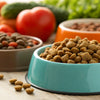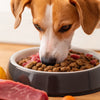Should You Feed Your Dog Kibble? A Comprehensive Guide to Choosing the Best Dog Food
- Houndsy
Table of Contents
Introduction
Did you know that nearly 60% of dog owners in the United States choose kibble as their primary pet food? This statistic highlights the immense popularity of dry dog food—a staple in many households. But as loving pet parents, we often find ourselves asking, is kibble really the best choice for our furry friends? With the rise of fresh and raw diets, along with varied opinions from veterinarians and pet nutritionists, the decision can feel overwhelming.
In this blog post, we aim to explore the question of whether we should feed our dogs kibble, delving into the intricacies of canine nutrition, the benefits and drawbacks of kibble, and alternative feeding options. By the end, we will not only provide you with the insights needed to make informed decisions for your beloved pet but will also emphasize how our innovative products, like the Houndsy Kibble Dispenser, can enhance your dog feeding experience.
Join us as we navigate the world of dog food, ensuring you have the knowledge to provide the best for your pet while reflecting on your own feeding routines.
The Evolution of Dog Food
Historically, our canine companions dined on scraps and leftovers from our meals. It wasn’t until the 20th century that commercial dog food began to gain traction. The introduction of kibble in the 1950s revolutionized the way we feed our dogs, offering a convenient, shelf-stable option that promised balanced nutrition.
However, the landscape of dog food has changed dramatically since then. We now have access to various options, from kibble and canned food to fresh and raw diets. Each type of food comes with its own set of pros and cons, making it crucial for us to understand what's best for our pets' health and happiness.
Kibble: What Is It?
Kibble, or dry dog food, is typically made by cooking ingredients at high temperatures, then extruding them into shapes and drying them. Most kibbles consist of a mix of meat, grains, vegetables, vitamins, and minerals, designed to provide a balanced diet.
While kibble is convenient and often cost-effective, its high carbohydrate content and processing methods have raised concerns among pet owners and nutritionists alike.
The Ingredients Matter
As we evaluate whether we should feed our dogs kibble, we must closely examine the ingredients.
- Protein Sources: Quality kibble should list a specific animal protein (like chicken or beef) as the first ingredient. However, some lower-quality options may use vague terms like "meat meal," which can come from various unknown sources.
- Grains and Carbohydrates: Kibble often contains grains and other high-carb ingredients, which can lead to obesity and digestive issues in some dogs. It's essential for us to choose a brand that balances these ingredients appropriately.
- Preservatives and Additives: Kibble contains preservatives to extend shelf life, but we should be cautious about artificial additives that can impact our pet’s health.
The Benefits of Kibble
Despite the concerns surrounding kibble, it does have some notable advantages:
- Convenience: Kibble is easy to store, measure, and serve. For busy dog owners, this can save a considerable amount of time.
- Dental Health: The crunchy texture of kibble can help reduce plaque and tartar buildup, promoting better dental hygiene.
- Cost-Effectiveness: Kibble is generally more affordable than fresh or raw diets, making it a practical choice for many families.
- Long Shelf Life: Kibble can be stored for extended periods without spoiling, allowing us to stock up without worrying about waste.
The Drawbacks of Kibble
However, there are several potential downsides to feeding our dogs kibble:
- High Carbohydrate Content: Many kibbles are packed with carbohydrates, leading to weight gain and other health issues, especially if our dogs are not highly active.
- Processing Concerns: The high-temperature processing can strip away valuable nutrients, resulting in a final product that may not provide the bioavailable nutrients our dogs need.
- Quality Variability: The quality of kibble can vary greatly between brands, and without thorough research, we may inadvertently choose a low-quality product.
Alternative Dog Feeding Options
As we weigh the pros and cons of kibble, it's essential to explore alternative feeding options that may better suit our dogs' needs.
1. Fresh Dog Food
Fresh dog food is prepared using real ingredients, like meats, vegetables, and grains, cooked minimally to preserve their nutritional integrity. Brands like Ollie offer fresh meal plans tailored to our dogs' specific health needs. This option often results in shinier coats, improved digestion, and higher energy levels in dogs.
2. Raw Diets
Raw diets consist of uncooked meats, bones, and vegetables. Advocates argue that this approach is more biologically appropriate for dogs, given their carnivorous ancestry. However, raw diets require meticulous handling to avoid contamination and might not be suitable for all dogs, especially those with health issues or compromised immune systems. Consulting a veterinarian is crucial before transitioning to a raw diet.
3. Mixed Feeding
For those who want the best of both worlds, mixed feeding offers a balanced approach. By combining kibble with fresh or raw food, we can provide our dogs with a varied diet that meets their nutritional needs while enhancing their mealtime experience.
Choosing the Right Food for Your Dog
When deciding what to feed our dogs, we must consider several factors:
- Age and Size: Puppies and senior dogs have different nutritional requirements. Larger breeds may require specific diets to support their growth and development.
- Activity Level: Active dogs need more calories, while less active dogs may benefit from a lower-calorie diet.
- Health Concerns: Dogs with allergies or specific health conditions may need tailored diets. Always consult with a veterinarian before making significant changes to your dog's diet.
- Taste Preferences: Just like us, dogs have their preferences. Ensuring the food is palatable can make a big difference in their willingness to eat.
The Role of Houndsy in Pet Care
At Houndsy, our mission is to simplify and elevate the dog feeding experience. We understand that the daily feeding ritual is a vital part of pet care, and we aim to enhance it with our flagship product, the Houndsy Kibble Dispenser.
The Houndsy Kibble Dispenser marries mid-century modern design with ergonomic convenience, allowing us to dispense perfectly portioned meals at standing height—eliminating the need for bending over. With a large storage capacity of 25-30 lbs and a BPA-free liner to keep food fresh, our dispenser not only functions flawlessly but also enhances the aesthetics of our home.
Explore the Houndsy Kibble Dispenser here and discover how it can transform your pet feeding routine!
Conclusion
In conclusion, the decision of whether we should feed our dogs kibble is complex and personal. Kibble offers convenience and cost-effectiveness but comes with potential downsides, including high carbohydrate content and processing concerns. As loving pet parents, we owe it to our furry companions to explore all available options, from fresh food to raw diets, to find what works best for their health and happiness.
Ultimately, the best choice will depend on our dogs' individual needs, preferences, and our lifestyles. By staying informed and making conscientious decisions, we can ensure our dogs lead vibrant, healthy lives.
As we reflect on our feeding routines, we encourage you to consider how the Houndsy Kibble Dispenser can enhance your daily pet care experience. Order Now and elevate your dog's feeding ritual!
FAQ
1. Is kibble a complete diet for dogs?
Yes, high-quality kibble is formulated to provide complete nutrition for dogs. However, it's essential to choose a reputable brand that lists specific protein sources and meets AAFCO standards.
2. Can I mix kibble with fresh food?
Absolutely! Mixing kibble with fresh or raw food can provide a more balanced diet and enhance your dog’s mealtime experience.
3. How do I know if I’m choosing a high-quality kibble?
Look for a kibble that lists a specific animal protein as the first ingredient, has minimal fillers, and avoids artificial additives. Reading reviews and consulting your veterinarian can also help.
4. Are there any risks associated with feeding raw diets?
Yes, raw diets can pose risks, such as bacterial contamination. It's crucial to handle raw food carefully and consult with a veterinarian for proper guidance.
5. How can the Houndsy Kibble Dispenser make feeding easier?
The Houndsy Kibble Dispenser allows for perfectly portioned meals at standing height, reducing mess and making feeding time more convenient. Explore its features here.












